Europe vs USA: Two Trucking Visions, One Need for Innovation
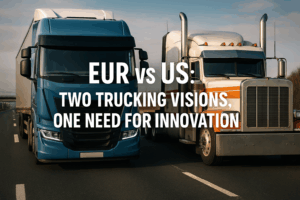
American trucks may inspire awe in movies with their long chrome noses, loud horns, and imposing road presence, but many drivers who’ve experienced both types agree: “European trucks are simply better designed.”
But where does this reputation come from? And more importantly, what lessons can we draw from these differences to improve safety and comfort for drivers everywhere?
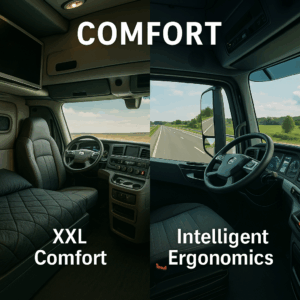
Comfort: Two Opposing Approaches
American Trucks: Maximum Space, Minimal Ergonomics
American trucks are known for their impressive habitability:
-
XXL cabins with large beds, fridges, microwaves, generous storage… everything needed for life on the road.
-
However: this space is often poorly designed in terms of ergonomics. Equipment is distant, poorly placed, and hard to reach.
-
Consequence: drivers must twist and stretch to access certain items, adopt unnatural postures, and experience increased fatigue.
-
Safety risk: physical discomfort reduces concentration, fluidity of movement, and reaction time. Ergonomics becomes essential for road safety.
Visually spacious and impressive, but sometimes counterproductive in daily use.
European Trucks: Smart Compactness Serving Comfort
European manufacturers focus on ergonomics and space efficiency:
-
Cab-over design for better turning radius, ideal in urban areas.
-
Driver seat well-aligned with controls, ensuring natural posture and reduced fatigue.
-
Intuitive, wraparound dashboard, allowing full control without taking eyes off the road.
-
Direct access to essential amenities (storage, bed, fridge) without unnecessary effort.
A more compact space designed to reduce fatigue and enhance safety and productivity.
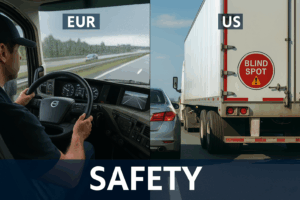
Safety: Integrated Systems vs Human Dependency
In Europe: Safety as a Built-in System
European regulations have progressively standardized embedded safety features in heavy trucks, resulting in a harmonized safety evolution:
-
Automatic Emergency Braking (AEBS) to avoid or reduce frontal collisions.
-
Lane Departure Warning Systems (LDWS) to prevent unintentional lane drifting.
-
Blind Spot Detection (BSD) to secure lateral maneuvers, especially in urban areas.
-
Driver Monitoring Systems (DMS) to detect drowsiness or distraction in real time.
In Europe, safety is structural, integrated from the design phase and backed by strong regulation. It’s a preventive, automated, and collective approach.
In the USA: Fragmented Systems
In contrast, North America offers greater freedom to manufacturers and carriers, which presents several challenges:
-
Lack of standardization: Safety features are often optional and vary between manufacturers and fleets.
-
Reliance on driver awareness: With fewer automated systems, safety depends more heavily on human attention, increasing the risk of human error on long-haul trips.
-
Customized technologies: While some companies invest in advanced tools, there’s no universal baseline—creating uneven safety levels.
Safety depends more on the company than on regulation, resulting in disparities across fleets and less consistent accident prevention.
Europe has embraced a culture of automated safety, while the U.S. still relies largely on driver responsibility.
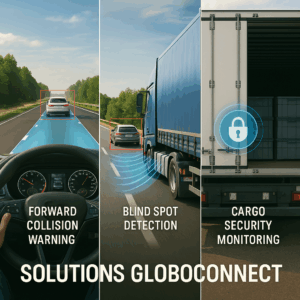
What GloboConnect Brings to the Table
At GloboConnect, we believe any truck—regardless of its brand or origin—can become a smart vehicle. With our embedded technology, it’s possible to:
-
Add a BSD (Blind Spot Detection) system to trucks without one, to detect lateral risks and prevent collisions during lane changes.
-
Deploy a DMS (Driver Monitoring System) to detect fatigue or distraction and alert drivers in real time.
-
Install connected dash cams for continuous video recording and 4G remote access.
-
Track performance via detailed driving reports: speeding, harsh braking, long stops…
-
Geolocate, analyze, and optimize usage with our complete web platform, compatible with temperature sensors, or smart padlocks.
-
Integrate an ADAS (Advanced Driver Assistance System) to prevent collisions through lane detection, adaptive cruise control, and safe following distances.
-
Map and monitor risk zones (black spots) to alert drivers before entering dangerous areas.
-
Enable remote engine cut-off to secure a stolen vehicle and facilitate recovery.
-
Add door sensors to detect unauthorized opening or cargo theft attempts.
-
Equip the vehicle with a SOS button, allowing drivers to send immediate emergency alerts
It’s not the size of the truck that matters—but how smartly it’s equipped.
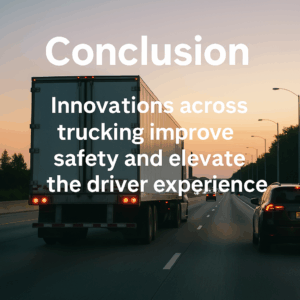
Conclusion
The future of road transport won’t be defined by a new truck model or a more powerful engine. It lies in a paradigm shift—placing embedded intelligence at the heart of every vehicle.
From real-time alerts to predictive data analysis, tomorrow’s trucks are safer, more efficient, and better adapted to their operating environments.
And this evolution is accessible. There’s no need to replace an entire fleet. The real opportunity lies in upgrading what’s already in place. With progressive integration of smart modules, companies can:
-
Enhance driver safety.
-
Reduce theft and accident risks.
-
Improve productivity and responsiveness.
-
Comply with regulatory and environmental requirements.
This is the soft, pragmatic, and customizable transition GloboConnect offers—technological, human, and strategic—tailored to real-world conditions.
Because in the end, it’s not the size of your truck that defines your performance, but the quality of the technology, vision, and ambition it carries.
Contact us to help you make this transition and improve the security of your fleet.